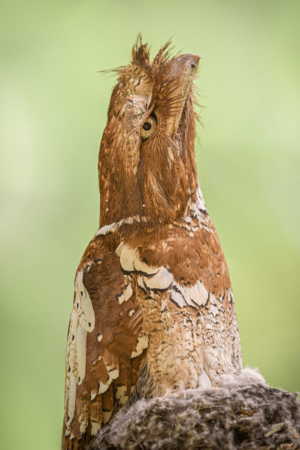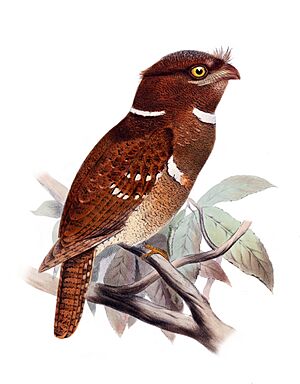Philippine frogmouth facts for kids
Quick facts for kids Philippine frogmouth |
|
|---|---|
 |
|
| Conservation status | |
| Scientific classification |
The Philippine frogmouth (its scientific name is 'Batrachostomus septimus') is a special bird that mostly comes out at night. You can find it all over the Philippine archipelago. It often lives in forests that are not too old and in areas where new trees are growing. This bird eats insects like grasshoppers, cicadas, crickets, and beetles.
Contents
What Does the Philippine Frogmouth Look Like?
Just like other frogmouth birds, the Philippine frogmouth has big eyes. These eyes help it see better in the dark. It also has a wide, flat beak, which is perfect for catching insects. Its feathers have special patterns that help it blend in with its surroundings. This way, it can hide easily while resting during the day.
This bird lives in the Philippines. People sometimes confuse it with the Philippine nightjar. Even though they look similar in shape, their feathers are very different.
The Philippine frogmouth is a medium-sized frogmouth. It grows to be about 24 to 26 centimeters (about 9 to 10 inches) long. These birds come in two main colors, plus some in-between shades. One color is a reddish-brown, and the other is a lighter brown with stripes of buff and black.
Both color types have three clear light bands on their bodies. One band is on the back of their neck. Another is on their lower throat. The third band goes around their lower chest. They have yellow-orange eyes and brown feet and beaks. Male and female frogmouths look alike, but females are usually a bit darker and plainer.
Where Does the Philippine Frogmouth Live?
The Philippine frogmouth is a bird that stays in one place. It is found only in the Philippines. You can see it in many parts of the islands, but it is not found in Palawan. Even though it is rare, some have been seen in India and Australia.
These birds are thought to live in lowland forests. They also like forests that are growing back but are not fully mature yet. We do not know much about their exact homes. This is because they are only active at night. Also, they do not sing loud songs or make many calls.
How Does the Philippine Frogmouth Live?
How Do They Have Babies?
Philippine frogmouths build their nests on a horizontal tree branch. The nest is usually about two to five meters (6 to 16 feet) above the ground. They make the nest using their own soft, downy feathers. They hold these feathers in place with spider silk, moss, and lichens.
The female bird lays only one egg each season. The male frogmouth sits on the egg during the day to keep it warm. The female takes over at night.
What Do They Eat?
Philippine frogmouths are good at adapting to different foods. They eat large insects. This includes grasshoppers, cicadas, crickets, and beetles. They hunt by waiting quietly on low branches. When they see an insect moving below, they quickly fly down to catch it.
Like other birds in their group (called Batrachostomus), Philippine frogmouths have long, stiff hairs around their beak. Scientists think these hairs help protect their eyes from insects they are trying to catch.
What Sounds Do They Make?
Male frogmouths make low, deep sounds. These sounds can be like woah, wash, Guam, or g-aw. They might also make a short, steady trill. Female frogmouths make louder calls. Their call is a short mewl that gets lower in sound.
Both male and female frogmouths have a harsh, growling call. They repeat this call several times every minute. They also have a harsh, quick scream. This scream is believed to be a warning call for danger.
Is the Philippine Frogmouth Safe?
The Philippine frogmouth is currently listed as a species of "least concern" by the IUCN. This means it is not in immediate danger of disappearing. This decision was made in 2012. However, experts believe its population is slowly getting smaller. This is mainly because of habitat destruction, which means their forest homes are being destroyed.
The reason it is listed as "least concern" is because it lives in a very large area. Also, its population is not declining fast enough to be called a vulnerable species. Even though we do not know the exact number of these birds, scientists think there are enough of them to avoid being considered vulnerable right now.



